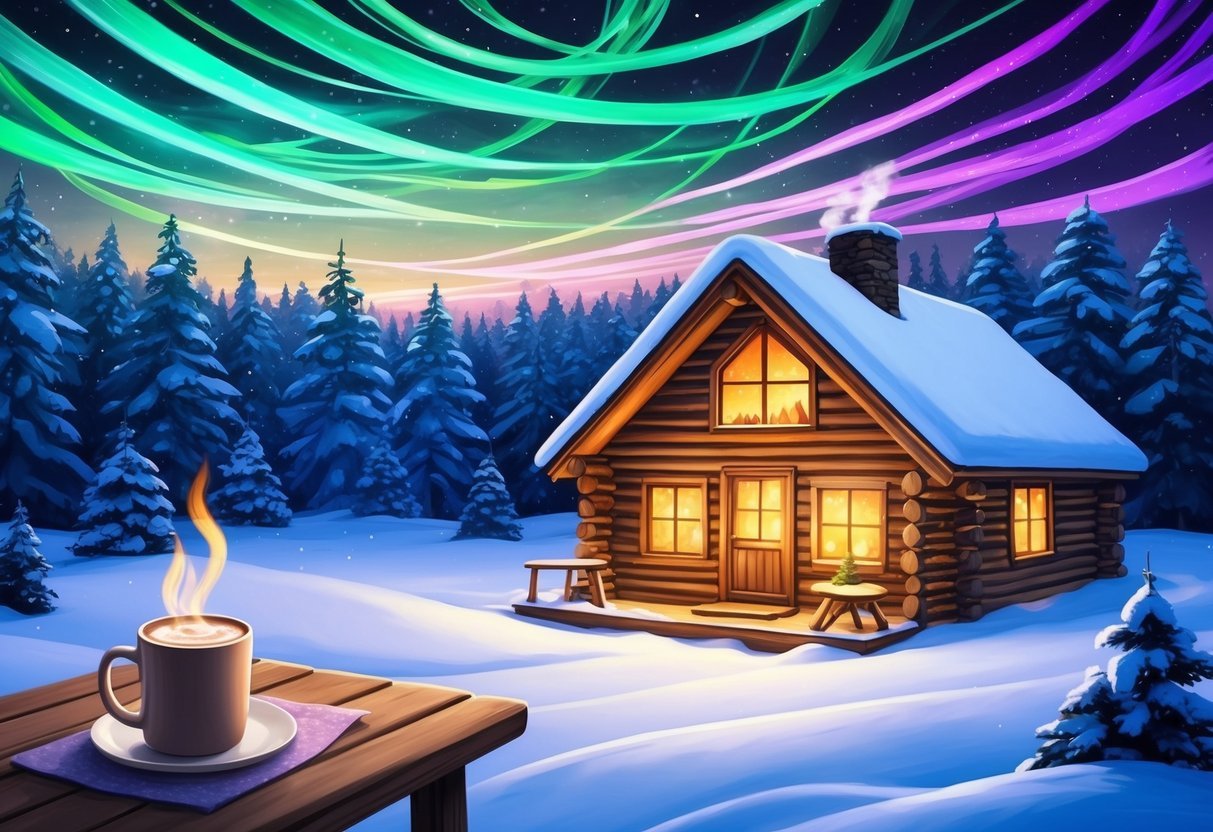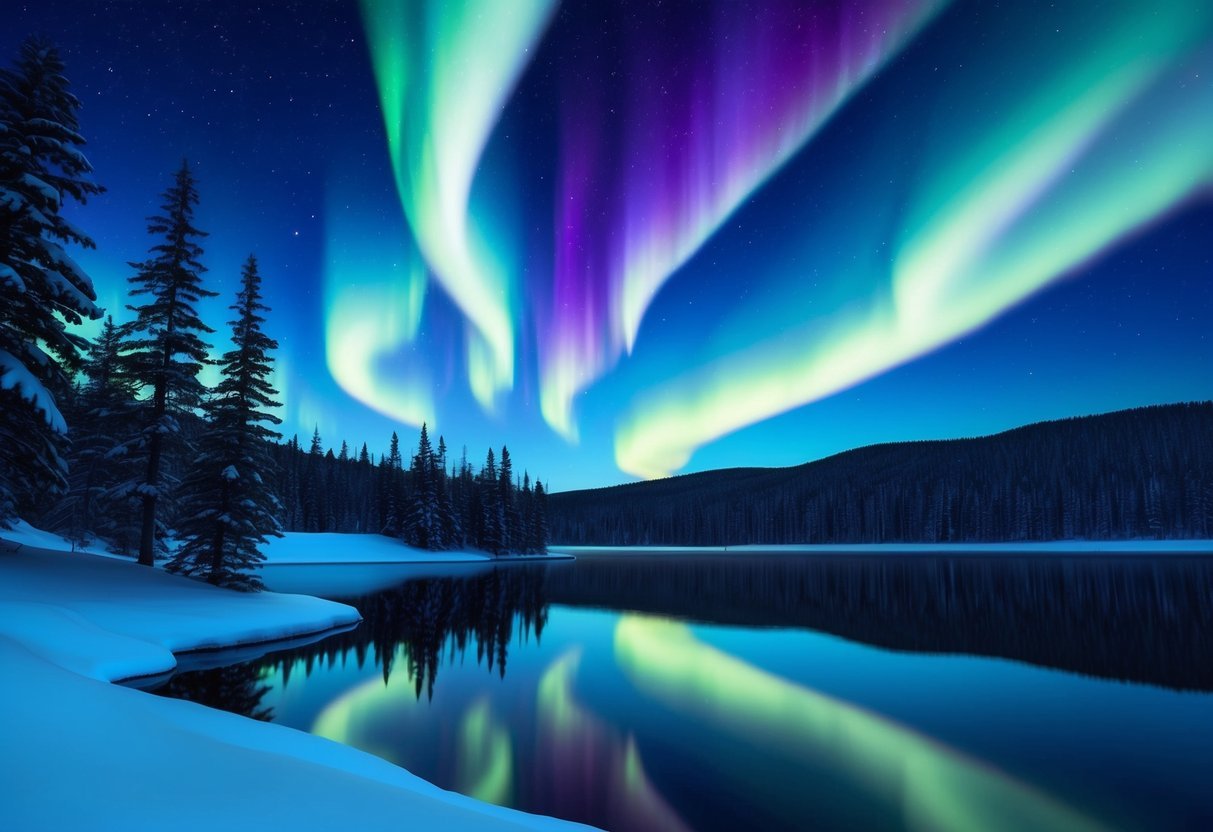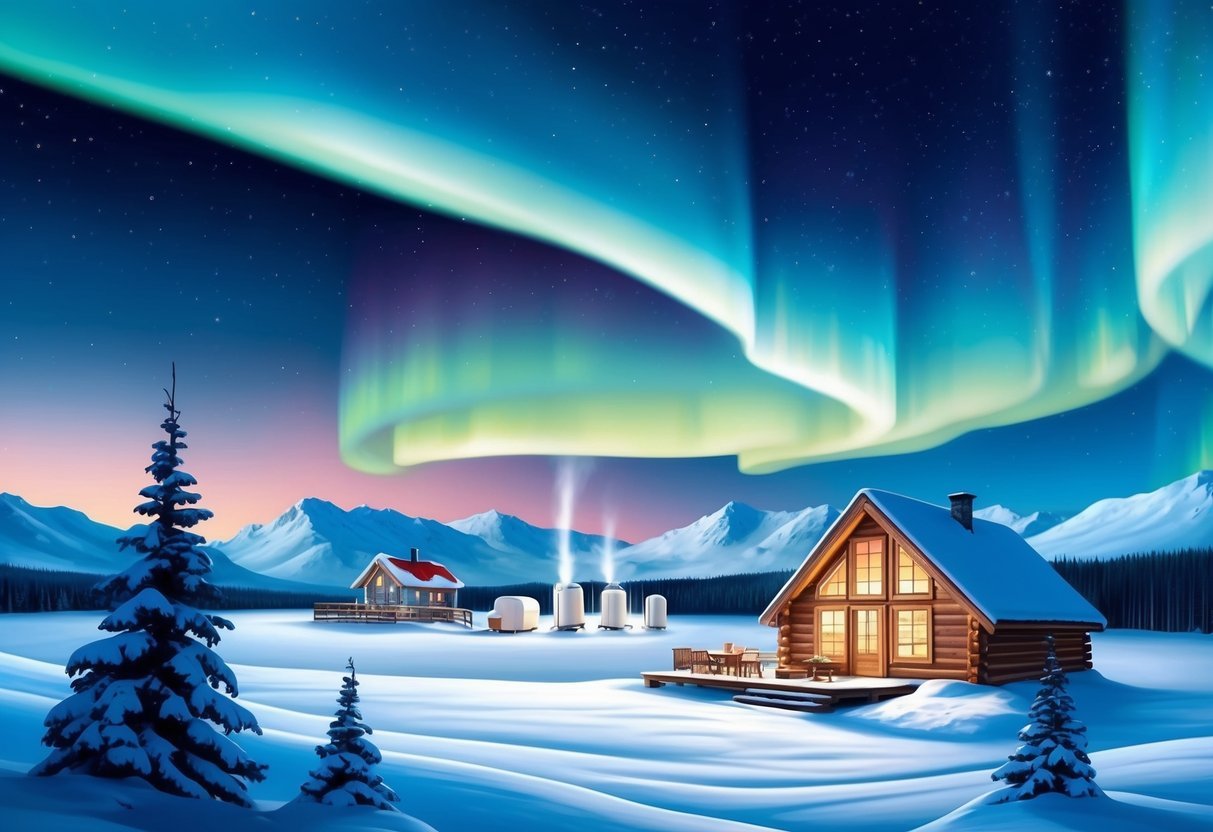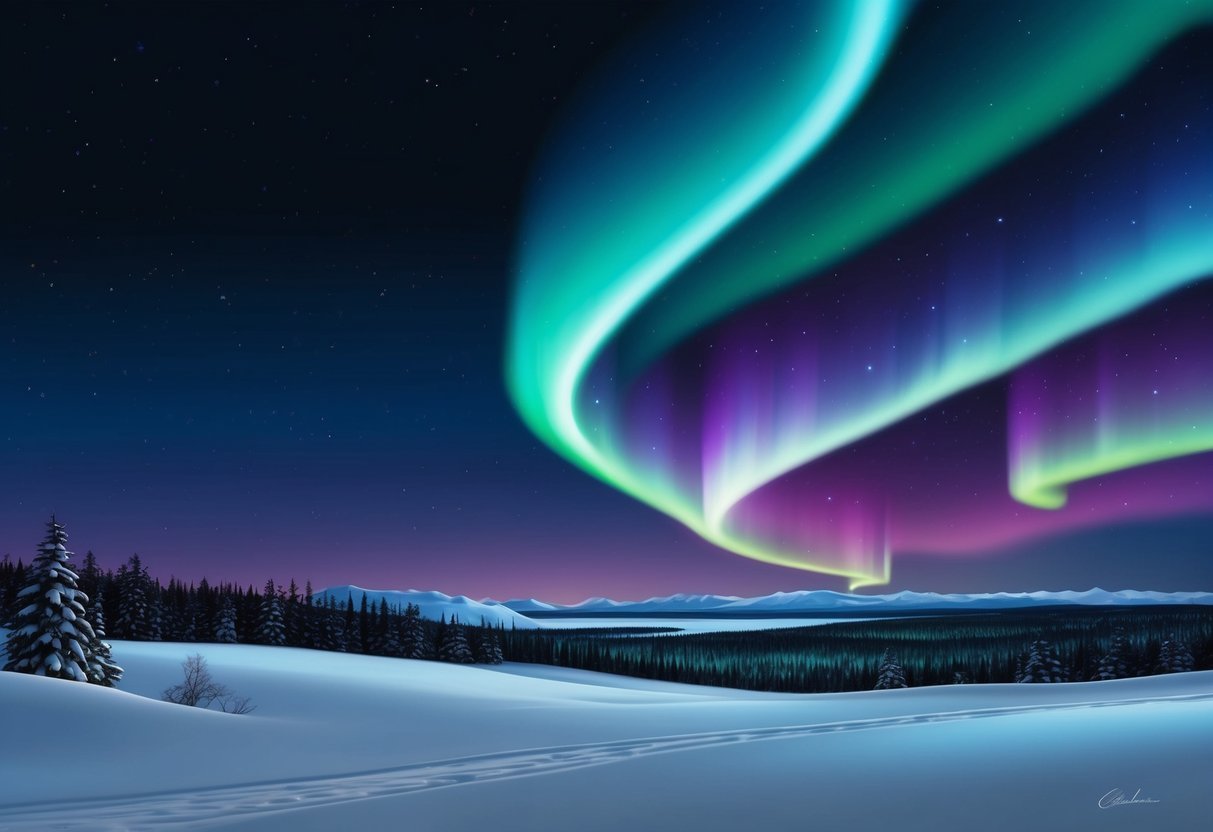The northern lights dance across Canada’s night sky, painting it with vibrant colors. This natural light show draws people from around the world. Seeing the aurora borealis in Canada is a magical experience.
Canada is one of the best places to see the northern lights. The best time to view the aurora in Canada is from September to March. During these months, the nights are longest and darkest. The lights appear more often in northern areas, but they can be seen in many parts of the country.
Watching the northern lights is easy and fun. People can check aurora forecasts to plan their trips. Finding a dark spot away from city lights helps. With some planning, anyone can enjoy this amazing sight in Canada’s beautiful outdoors.
What are the Northern Lights?
The Northern Lights, or Aurora Borealis, are a dazzling light show in the night sky. They appear as colorful ribbons dancing across the darkness, creating a magical sight for viewers.
The Science of Auroras
The Northern Lights happen when the sun sends out charged particles called solar wind. These particles travel through space and bump into Earth’s magnetic field. When they hit the air in our upper atmosphere, they make it glow.
Different colors show up based on which gases the particles hit:
- Green: oxygen at lower heights
- Red: oxygen at higher heights
- Purple and blue: nitrogen
The lights often look like moving curtains or rays in the sky. They can be seen best in the Northern Hemisphere, in a ring-shaped area called the aurora zone.
Historical Significance in Canada
For thousands of years, the Northern Lights have been important to people in Canada. Many First Nations groups have stories about the lights. Some thought they were spirits of their ancestors dancing in the sky.
Early European explorers were amazed by the lights when they came to Canada. They wrote about the colorful shows in their journals. This helped spread interest in the Northern Lights around the world.
Today, the Aurora Borealis is a big draw for tourists in Canada. Places like Churchill, Manitoba and Yellowknife in the Northwest Territories are famous spots to see them. The lights have become a symbol of Canada’s beauty and mystery.
Best Time to See the Northern Lights in Canada
The Northern Lights dance across Canadian skies at different times throughout the year. The best viewing periods depend on darkness, season, and location. Let’s explore when you can catch this amazing light show.
Winter and the Darkness Advantage
Winter offers the best chance to see the Northern Lights in Canada. From December to March, long nights provide more viewing time. The cold weather brings clearer skies, perfect for spotting the aurora.
In places like Yellowknife, viewers might see the lights for hours. The darker it is, the brighter the lights appear. Dress warmly and head out after 10 PM for the best show.
Many tour companies offer winter aurora trips. These guided experiences help visitors find the best viewing spots.
Spring and Fall Equinoxes
The equinoxes in March and September are great times for aurora viewing. These periods often have more solar activity, which can lead to brighter displays.
Late August through April is considered the prime aurora season across Canada. Fall brings longer nights but milder temperatures than winter.
Spring offers a mix of dark skies and warmer weather. This makes outdoor viewing more comfortable. Popular spots like Churchill, Manitoba shine during these seasons.
Summer Viewing Challenges
Summer presents challenges for seeing the Northern Lights in Canada. Long daylight hours mean less darkness for viewing. In far northern areas, the midnight sun can last for weeks.
However, it’s not impossible to see the aurora in summer. Very dark nights in August might offer a glimpse. Viewers need to stay up late or wake up very early.
Summer aurora hunters should head to more northern locations. The further north, the better the chances of darkness and aurora sightings.
Top Locations for Viewing the Northern Lights
Canada offers some of the best spots to see the Northern Lights. These places have dark skies, long nights, and great viewing conditions.
Yellowknife: A Prime Spot
Yellowknife, in the Northwest Territories, is a top place to see the Northern Lights. It sits under the aurora oval, making it ideal for viewing. The city has clear skies and long, dark nights from fall to spring.
Yellowknife tours take visitors to prime viewing spots. These trips often include heated viewing areas and expert guides.
Many hotels in Yellowknife offer aurora wake-up calls. This way, guests don’t miss the show if it starts late at night.
The best time to visit is from mid-August to mid-April. During this time, the nights are long enough to see the lights.
Churchill: Polar Bears and Auroras
Churchill, Manitoba is known for both polar bears and Northern Lights. Its location on Hudson Bay makes it a great spot for aurora viewing.
The town has special viewing areas called “aurora domes”. These heated domes let visitors watch the lights in comfort.
Churchill’s Northern Lights season runs from January to March. This is when the nights are longest and darkest.
Visitors can combine aurora viewing with other arctic activities. These might include dog sledding or wildlife tours.
Whitehorse and Yukon Territory
Whitehorse, in the Yukon, is another top spot for Northern Lights. The city has low light pollution and many clear nights.
Visitors can stay in special aurora-viewing lodges outside the city. These lodges offer cozy rooms and outdoor viewing areas.
The Yukon’s aurora season runs from August to April. The best months are usually February and March.
Many tours in Whitehorse combine aurora viewing with other activities. These might include snowshoeing, ice fishing, or visiting hot springs.
Jasper National Park: Dark Sky Preserve
Jasper National Park in Alberta is a Dark Sky Preserve. This means it has very low light pollution, perfect for seeing the Northern Lights.
The park holds a Dark Sky Festival each October. This event has special talks and viewing sessions.
Visitors can see the lights from many spots in the park. Popular areas include Pyramid Lake and Maligne Lake.
The best time to see the lights in Jasper is from October to March. The park offers guided night sky tours during this time.
Jasper also has great daytime activities. Visitors can ski, hike, or take a scenic drive while waiting for night to fall.
Preparing for Your Aurora Viewing Trip

Getting ready for a northern lights trip in Canada takes some planning. Here are key things to think about for your aurora adventure.
Accommodation and Tours
Northern Lights tours in Canada offer great ways to see the aurora. Many tour operators provide cozy lodges or hotels near prime viewing spots. Some even have special heated viewing areas.
Booking a tour can make your trip easier. They often include transport and expert guides. These guides know the best times and places to see the lights.
For a more rustic experience, try camping. Some parks allow overnight stays. This can give you amazing views away from city lights.
Transportation Tips
Getting to aurora viewing spots can be tricky. Many are in remote areas, so renting a car might be a good idea. This gives you freedom to explore.
Some tour companies offer bus trips to viewing areas. This can be easier if you’re not used to winter driving.
In very remote spots, you might need to take a small plane. Check if your tour includes this. If not, book flights early.
Weather Conditions and Clothing
Canadian winters can be very cold, so dress in warm layers. Wear a thick coat, hat, gloves, and boots. Thermal underwear is a must.
Check the weather forecast before you go out. Clear skies are best for seeing the lights, so be ready for quick weather changes.
Bring hand and foot warmers. These can keep you comfy during long viewing sessions. A thermos with hot drinks is also nice to have.
Pack a good camera if you want to take photos. Bring extra batteries too, as cold weather can drain them fast.
Photographing the Northern Lights

Capturing the Northern Lights on camera takes skill and preparation. The right equipment, settings, and location are key to getting stunning aurora photos.
Best Practices for Aurora Photography
To photograph the Northern Lights, you’ll need some specific gear. A camera that can do long exposures is a must. Bring a sturdy tripod and remote shutter release to keep the camera still.
For camera settings, start with these:
- Aperture: f/2.8 or widest available
- ISO: 1600-3200
- Shutter speed: 5-15 seconds
- White balance: 3500K
Use manual focus and set it to infinity. A wide-angle lens helps capture more of the sky.
Take test shots and adjust as needed. The Northern Lights can move fast, so try different shutter speeds. Shorter exposures freeze the aurora’s shape, while longer ones create light trails.
Understanding Light Pollution
Light pollution makes it harder to see and photograph the aurora. It’s best to get far from city lights, so look for dark sky areas or national parks.
Some tips for dealing with light pollution:
- Use apps to find dark sky locations
- Check moon phases – a full moon creates natural light pollution
- Face your camera north, away from nearby light sources
Even with some light pollution, it’s still possible to capture the aurora. Use a light pollution filter on your lens. In post-processing, you can also adjust contrast to make the lights pop more.
Joining Northern Lights tours can be helpful. Guides know the best spots and can give photography tips.
Cultural Significance and Local Myths
The Northern Lights hold deep meaning for many Canadians. Different groups have their own stories and beliefs about the Aurora Borealis.
Indigenous Perspectives
Many Indigenous peoples see the Northern Lights as sacred. Some Inuit believe the lights are spirits of the dead playing with a walrus head. The Cree see them as ancestors dancing in the sky.
For some groups, the Aurora connects them to the land and cosmos. It’s not just pretty – it’s part of their culture and history.
Some Indigenous stories say the lights can help with healing. One legend tells of a boy who used the Aurora to travel and became a great healer.
Modern Canadian Interpretations
Today, many Canadians see the Northern Lights as a natural wonder. Tourists flock to places like the Canadian Rockies to see them.
Some think the lights bring good luck. Others say they make wishes come true. Many just enjoy their beauty.
Indigenous-led tours let people learn old stories while watching the Aurora. This mixes old and new views of the lights.
For all Canadians, the Northern Lights are a special part of living in the north. They remind people of Canada’s natural beauty and rich culture.
Unique Northern Lights Experiences in Canada
Canada offers amazing ways to see the northern lights. Visitors can enjoy thrilling activities while watching the sky glow with colorful auroras. These special experiences create lasting memories.
Dog Sledding Under the Auroras
Dog sledding is a fun way to see the northern lights in Canada. Visitors can ride on sleds pulled by eager huskies through snowy forests and across frozen lakes. The dogs’ excited barks mix with the quiet of the night as the sky lights up with green and purple streaks.
Many tour companies offer nighttime dog sledding trips to watch for the aurora. Guests bundle up in warm blankets on the sled as skilled mushers guide the dogs. Some tours include stops to enjoy hot drinks and snacks while waiting for the lights to appear.
This activity lets people experience an old way of Arctic travel while seeing nature’s light show. It’s a magical mix of adventure and beauty that’s hard to find anywhere else.
Tundra Buggy Adventures
Tundra buggies are big vehicles made to drive safely over snow and ice. These special trucks take guests out onto the frozen tundra at night to see the northern lights. The buggies have big windows and viewing decks to give the best views of the sky.
Churchill, Manitoba is a top spot for tundra buggy aurora tours. The town sits right under the aurora oval, where the lights are brightest. Guides drive the buggies away from town lights to dark spots perfect for aurora watching.
Inside the heated buggies, people can stay warm while looking for polar bears and other wildlife. Some tours include photography tips to help guests capture great shots of the lights dancing overhead.
Northern Lights Festivals
Several Canadian towns host festivals to celebrate the northern lights. These events mix aurora viewing with fun activities and learning about local culture.
The Jasper Dark Sky Festival in Alberta is a big draw each October. It offers stargazing parties, talks by space experts, and nighttime adventures in Jasper National Park. The park’s dark skies are perfect for seeing the auroras.
Yellowknife in the Northwest Territories holds an aurora festival in March. Visitors can enjoy dog sledding, ice fishing, and indigenous cultural shows. At night, everyone heads out to watch for the lights.
These festivals are great for meeting other aurora fans and learning more about the science behind the lights. They offer a mix of daytime fun and nighttime wonder under glowing skies.
Wildlife and Nature During Aurora Season

Visitors to Canada during aurora season can witness amazing wildlife and natural wonders. The northern regions offer unique chances to see polar bears and explore vast boreal forests under the dancing lights.
Polar Bears in Churchill
Churchill, Manitoba is known as the “polar bear capital of the world.” In late fall, these huge white bears gather near Hudson Bay. They wait for sea ice to form so they can hunt seals.
Tourists can take tundra buggy tours to see polar bears up close. The bears often play and wrestle in the snow. Sometimes lucky visitors spot mothers with cubs.
Churchill also has arctic foxes, arctic hares, and snowy owls. In summer, thousands of beluga whales swim in the bay. Watching wildlife under the northern lights is an unforgettable experience.
The Boreal Forest Ecosystem
The boreal forest covers much of northern Canada. It’s home to many animals like moose, wolves, and lynx. Millions of birds nest here in summer.
This huge forest helps fight climate change. The trees soak up lots of carbon dioxide. Lakes and bogs store even more carbon.
Visitors can hike or canoe to explore the forest. They might see beaver dams or hear loons calling on misty lakes. When night falls, the aurora often shimmers above the dark trees.
Aurora Forecasting and Scientific Research
Tracking the northern lights relies on advanced prediction tools and dedicated research. Scientists study space weather patterns to forecast aurora activity and help people plan their viewings.
Aurora Alerts and Predictions
Aurora Forecast websites give real-time updates on northern lights activity. They use data from satellites and ground stations to predict when and where auroras might appear. These tools help both beginners and experts plan their aurora viewing trips.
Space weather plays a big role in aurora forecasts. Solar flares and storms can cause more intense auroras. Many sites offer email or text alerts when strong auroras are likely.
Some forecasts use a scale to rate expected aurora strength. This helps viewers know if they might see faint glows or bright, dancing lights.
Research Institutions and Observatories
Canada has many places that study the northern lights. The Churchill Northern Studies Centre in Manitoba is a key spot for aurora research. They watch the skies and teach people about space science.
Universities across Canada also study auroras. They use special cameras and tools to learn more about these light shows. Some have observatories where people can visit and learn.
Scientists use this research to better understand Earth’s magnetic field. It also helps them learn about how the Sun affects our planet. This work improves space weather predictions, which is important for satellites and power grids.
Tips for a Sustainable Aurora Adventure

Seeing the Northern Lights in Canada can be an amazing trip. But it’s important to be kind to the environment and local people. Here are some ways to make your aurora trip eco-friendly and helpful to communities.
Eco-Friendly Travel Practices
Choose eco-friendly transportation when possible. Take trains or buses instead of flying when you can. If you rent a car, pick a hybrid or electric model.
Pack light to reduce fuel use. Bring a reusable water bottle and shopping bag. Don’t use single-use plastics.
Stay at green hotels or lodges. Look for places with energy-saving features and recycling programs. Some spots use renewable energy like solar power.
Respect nature when viewing the lights. Don’t leave trash behind or disturb wildlife. Stay on marked trails and viewpoints.
Supporting Local Communities
Book tours with local operators. They know the best spots and support the local economy. Ask about their eco-practices before booking.
Eat at local restaurants and buy souvenirs from area shops. This puts money into the community.
Learn about native cultures. Many aurora spots have rich indigenous history. Take a tour led by local guides to hear their stories.
Donate to local environmental or community groups. Even small amounts can make a big difference in small towns.
Frequently Asked Questions

Seeing the Northern Lights in Canada is a magical experience. Many people have questions about this natural wonder and how to plan a trip to see it.
Common Questions About the Aurora
The Northern Lights, or aurora borealis, are colorful lights in the sky. They happen when particles from the sun hit Earth’s atmosphere. The lights can be green, pink, purple, or white.
People often ask when to see the aurora. Fall and winter are best, from September to March. Nights are longer then.
Another common question is where to go. Churchill, Whitehorse, and Yellowknife are top spots. These places sit under the “aurora oval” where the lights are brightest.
The lights don’t show up every night. It depends on solar activity and weather. Clear, dark skies are needed.
Practical Tips for Travelers
Plan your trip carefully. Make sure to book a tour or hotel that offers aurora viewing.
Dress warmly. Nights get very cold in the north. You should wear layers, warm boots, and thick gloves.
Bring a good camera. Use a tripod for clear shots. Also, turn off the flash. If you need to, learn night photography before you go.
Be patient. The lights can appear at any time. They might last minutes or hours.
Some hotels have “aurora alarms” to wake guests when the lights appear. Ask about this when booking.
Remember, seeing the aurora is never guaranteed. Enjoy other activities too, like dogsledding or ice fishing.

